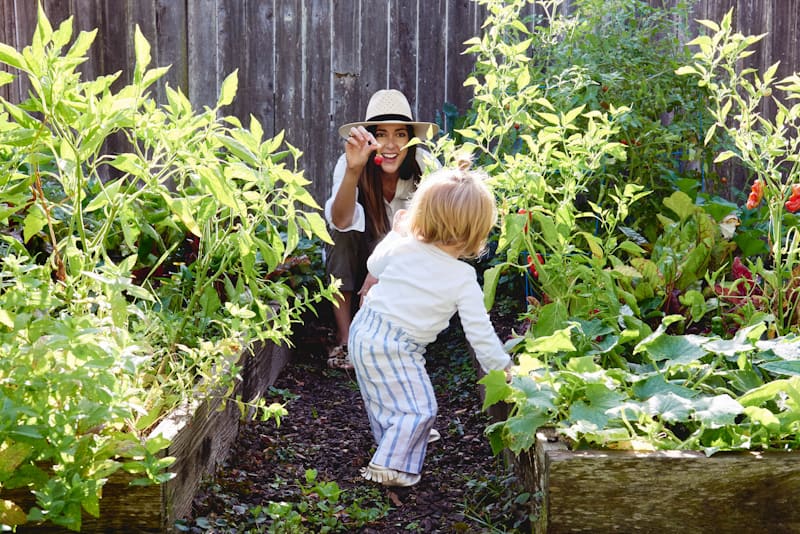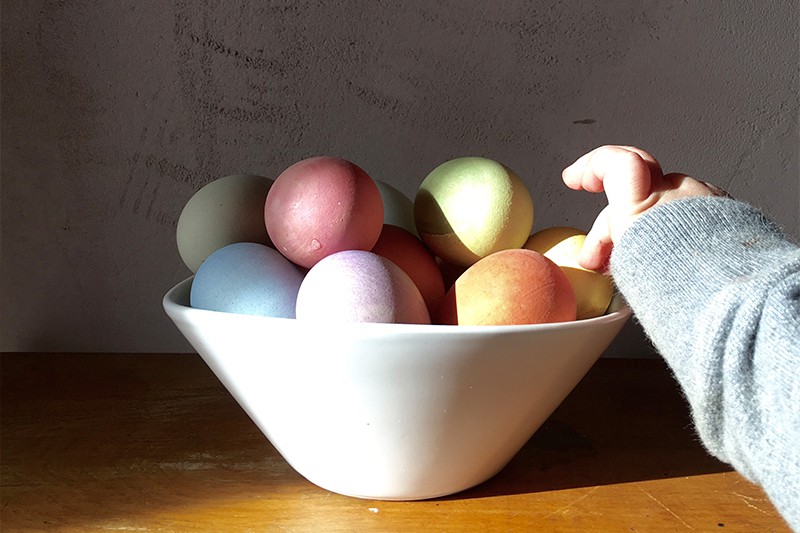
Gardening 101: What You Need To Know
Written by Mimi Clarke
Photography by Maria Del Rio
With spring in the air, more time spent at home, and grocery store runs spread out for safety reasons, there seems to be no time like the present to start a garden. If you’re a total novice or just want to freshen up your knowledge and skills, you’ve come to the right spot. We’ve tapped Mimi Clarke—the owner of San Francisco-based Fiddle Fern Landscaping and past MOTHER subject (you might remember her unique cross-country parenting relationship!)—to show us the way. In addition to being an in-demand landscaper for a variety of private clients, the mother of one (Logan, 6), also served as lead horticulturist for the dreamy and historic Filoli Gardens before launching her own biz. Needless to say, this lady knows her stuff. Below, she walks us through some common questions on how to plant a garden at home.
If planting this month (April), which crops should one start with as a beginner?
“This entirely depends on where you live and when the threat of frost has lifted. For example, where I live in the San Francisco Bay Area, April-May plantings consist of lettuce, radish, pea, bean, carrot, beet, tomato (plants), pepper (plants), cauliflower (plants), cucumber, chard, kale, celery, and a variety of other greens. The most important thing for the beginner is to start small and get a feel for it.”
How does one determine whether to use starts or seeds?
“Beginners can benefit from the shortcut of buying nursery grown starts as they are less vulnerable to pests and provide instant garden gratification. These are plants that were started in a greenhouse and are ready to plant in the ground. You can also start seeds indoors yourself and give your crops a head start on the growing season. A lot of seeds can be started indoors, but some are better off being sown directly into the garden. Some crops, such as root vegetables, do not transplant well and should be directly sown. Tomatoes and peppers, on the other hand, can tolerate being transplanted and are typically started indoors. My recommendation for the novice gardener is to buy starts from a reputable garden center and see how they grow. Once you get the hang of it, mix in sowing seed. There is nothing more satisfying than growing your food from seed. It’ll be hard to turn back.”
How does someone get supplies now that garden shops are closed?
“A lot of the nurseries and garden centers are closed for in-store shopping, but you can place orders over the phone and do curbside pickups. Here are a few online resources I know and like: Gardeners Supply Company, Baker Creek Heirloom Seeds, Peaceful Valley, and Harmony Farm Supply.”
Is it as simple as following the instructions on the seed packets, or do you have additional tips?
“The seed packet information is valuable and worth paying attention to. It’s important to plan your garden with the days to maturity in mind, how many days from sow date to harvest date. This information is on the seed packet and it will help you organize your space. Know that plants are categorized by how long they will occupy the bed. If done properly, you can extend your gardening year significantly. For this reason, I recommend sowing in succession. Be sure to protect your seeds from pests by covering them. I have had huge success with these products—summerweight row covers and a deep root seedstarting system.”
Are raised beds always necessary?
“Although not necessary, I am a huge fan of raised beds for vegetable gardening. They make life easier and offer a lower maintenance way to grow food. They provide several benefits such as warming up the soil more quickly in spring so that you can get a head start, helping to control weed populations, solving drainage issues, and adding aesthetic value to the garden. It’s hard not to like them. For a city dweller, it might be the only option for getting a garden growing.”
What are the basics of building a raised bed?
“The most important design consideration of a raised bed is the width. It should be narrow enough to reach the center without too much effort, the length is not important and the depth can vary from 6’’ high to 3’. A taller bed helps if you have trouble bending over. They can be built from various materials and should be located in the sunniest microclimate of the yard. It is also important to use the right medium for filling the beds. Don’t use bags of potting mix or planting mix as they are expensive, retain moisture, don’t hold fertility, and are intended for smaller containers. Bags of planting mix are basically potting mix with more sand in it. Instead, if possible, build up your existing soil by adding organic matter or compost. Look for a product that is amended sandy loam soil designed specifically for vegetables. These types of products utilize organic materials, such as horse and cow manure, grape compost, and cocoa bean hulls, and will provide a long lasting nutrient source. They can be blended with existing soil or used to fill the raised beds. I also add some sort of compost to my garden every time I do a planting. It’s important to think of your soil as a living thing that requires continued supplementation.”
Do you need an irrigation system or can you just hand water?
“An irrigation system is not essential, but it sure does help. I have found that a simple drip irrigation set up is the best system for vegetable gardening and has allowed me to expand my garden while not feeling bound to it. The amount of water and the frequency it is applied varies depending on your environment and the stage of the plant material. A rule of thumb for mature plants is to let the top couple inches of soil dry out before watering again. This typically translates to watering every third day. For newly sown seeds, you will need to water everyday to ensure constant moisture for the seed to germinate.”
What is thinning, and is it essential?
“Thinning is a term used to mean the removal of some plants, or parts of plants, to make room for the growth of others. So, for instance, if you directly sow a row of radish seeds and they all successfully germinate, you would go through and thin out some of the young seedlings to allow the others enough space to develop. This is a common practice and I strongly recommend doing it. The same thinking is applied to fruit trees. For a cluster of 6 apples on a branch, one would thin the fruit to 2 or 3 apples in order to encourage the development of larger fruit.”
Any tips for keeping pests away without using chemicals?
“I break down pest management into four categories—Cultural, Mechanical, Biological, and Chemical. I use all four of these methods in my garden in various combinations, but I would say that most of my efforts are spent on cultural and mechanical methods. Read more about them below:
Cultural Methods: These include basic gardening practices, such as proper spacing and planting depth, choosing varieties that have disease resistance, consistent watering practices, continuously improving the health of the soil with organic materials, fertilizing properly, and keeping a tidy space. Mulch is your best friend. This is an organic material applied to the surface of the soil, it reduces weed growth, and aids the soil with moisture retention and fertility, all while looking beautiful.
Mechanical Methods: These involve a more physical component. The use of traps and barriers, cover cloths like the one I previously mentioned, hand removal of diseased plant material and insects, washing plants off to control pest populations, and maintaining a weed-free environment.
Biological Methods: This is where you introduce natural predators into your garden to help you do some of the work. These may be insects, worms, or bacterial components. For example, ladybugs.
Chemical Methods: These don’t have to be toxic materials and there are several products on the market that are helpful. Soap sprays, oil sprays, and natural baits such as iron phosphate for slug and snail control.”
Is there an ideal method for harvesting lettuces and herbs?
“A good rule of thumb is to never harvest more than 50% of a plant at one time, but there are several exceptions and it depends on the type of plant. Leaf lettuces are harvested from the outer leaves once the plant has reached about 4’’ in height. Allow the younger, inner leaves to grow. Leaf lettuce can be harvested in this fashion for an extended period of time. Meanwhile, head lettuces are harvested once the head feels firm and full. Hot weather will cause them to bolt, go to seed, rather than fill out. Herbs are harvested in accordance with their life cycle. See more specifics below:
Annuals: Plants living their life in a single season such as basil or dill. They can be clipped as needed through the growing season but will die back and need replanting each spring.
Biennials: Plants living their life over a period of two years, like parsley. These can be harvested throughout the year but will need to be planted at various times to carry on the supply of new plants.
Perennials: Plants that persist year after year, such as oregano, rosemary, or thyme. They can also be harvested throughout the year and don’t need to be replanted on a regular basis.
Note that scissors are fine to pick with, though simply pinching with your thumb and forefinger work, too.”
Once your garden is growing, do you just let it keep doing its thing forever, or should you eventually pull out the plants and start over?
“You should be able to do three main plantings within a year with several succession plantings for those plants with rapid life cycles, such as radish or arugula. Paying attention to the days to harvest is crucial when planning this out. I do a fall garden planting in late summer, a spring garden planting in early spring, and a summer garden planting in late spring.”
Any books or other resources you recommend for learning more?
“There is so much information out there, but I like these sites: The Old Farmer’s Almanac, Pacific Horticulture Society, and UCCE Capitol Corridor. For books, I recommend Golden Gate Gardening: The Complete Guide to Year-Round Food Gardening in the San Francisco Bay Area & Coastal California by Pamela Peirce, The New Sunset Western Garden Book: The Ultimate Gardening Guide by the editors of Sunset, Vegetable Literacy: Cooking and Gardening with Twelve Families from the Edible Plant Kingdom, With Over 300 Deliciously Simple Recipes by Deborah Madison, and Gardening at the Dragon’s Gate: At Work in the Wild and Cultivated World by Wendy Johnson.”
For more on Mimi, be sure to check out her MOTHER profile and her Instagram feed.
And for more tips on gardening, peep this list of 10 Easy Foods To Plant At Home.
Share this story




